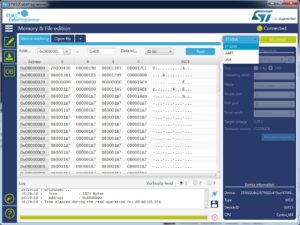2018 started on a bright note, and the Community continued to shine even brighter. Amidst significant discussions on security during the Consumer Electronics Show, ST showed a solution to secure Telemaco3P systems to protect cars against hackers. The trade event was also an excellent opportunity for our engineers, partners and community members to come together around the ideas and technologies that will shape what we do this year and beyond.
January was also a meaningful month for the Community because we were able to fix most of the problems that had bogged down certain aspects of the platform. Hence, if you suffered from some of these issues, we sincerely thank you for your patience, and we encourage you to revisit the Community because we believe it remains one of the best tools to bring enthusiasts, experts, and engineers together to create something that’s greater than the sum of its parts. Hence, instead of a traditional monthly report, as we have done in the past, we want to highlight some of the timeless contributions that make the Community a special place for so many people.
1: Sharing Experiences

The Community is about sharing. Often that means sharing an experience with an ST product as Clive One, a senior engineer and a very active member, did in a post about the B-L072Z-LRWAN1 LoRa Discovery Kit. He first shared firmware files and demo application, then offered an analysis of the pins of the Murata module on the board to help developers get their projects running quicker. Clive One then meticulously detailed his experiments with the board to test the antenna’s range in different settings, which also led him to explain the hurdles he encountered and what he did to fix them.
Today, the post serves as a reference for anyone trying this Discovery kit for the first time. New community members also come to this particular thread to ask questions about the board, and Clive One continues to offer support and guidance, which led other members to join the conversation. Hence, as ST adds more features and updates the Discovery kit’s firmware and expansion packs, we’re sure more people will continue to use Clive One’s post as a launchpad for their project.
2: Creating Solutions
Another example of how people give back to their community is a patch by pavel a to fix issues with USB peripherals and ST’s microcontrollers (MCU). The community member that goes by the username 1Ashena M created a thread to explain that it was impossible to read data from some USB keyboards when using the STM32F205RCT6 on a custom PCB. The message led others to share similar concerns with different MCUs and projects, and Clive One intervened to explain that, unfortunately, not all keyboards or mice behave the same way.
Indeed, the code ST that handles these USB peripherals may not work because they have an unexpected implementation of significant protocols that make them incompatible with it. For instance, as pavel a explains further down in the thread, some mice claim to support boot protocol, which is something that ST’s code actually needs and checks for, but they either lie or don’t handle it properly, leading to incompatibilities.
To partially solve this issue, pavel a wrote a patch to move from state HID_INIT to state HID_SYNC, instead of HID_IDLE. Basically, the code forces a different state instead of remaining stuck because of a weak implementation within the peripheral. The solution is tremendously helpful and Amel N, from ST, shared the fix with our development team to see how it could be implemented into our standard code. Ultimately, this is an excellent lesson on USB devices and a testament to how members give back to the community by sharing solutions to edge cases that can prove very troublesome.
- USB host
3: Working Together

Finally, Community members were ecstatic to discover STM32CubeProgrammer, a new software centralizing major management operations for STM32 platforms, such as firmware update, ST-Link configuration, and more, all in an optimized and convenient graphical user interface. Available for Windows, macOS, and Linux, the tool also helps developers use their MCU’s Single-Wire Debug (SWB) or JTAG debugging ports. As many questions and contributions on the Community tend to evolve around application development and MCU configuration, having a single tool to centralize all these needs is extremely practical, and it also helps answer questions faster and more efficiently. Similarly, it simplifies operations by enabling programming access to the MCU’s I2C and CAN ports.
Additionally, the thread dedicated to the software was beneficial as it helped users navigate the first bugs that sometimes hindered the installation process. It’s also a great place to share feedback and report any other issues one may encounter. We, therefore, encourage engineers to download STM32CubeProgrammer and use its thread to ask any questions, share their experience, or report a problem.
- STM32CubeProgrammer – New All-in-one Software Tool
